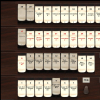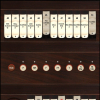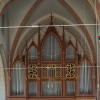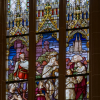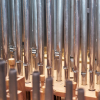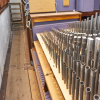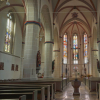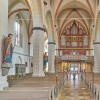Dingelstaedt Virtual Organ
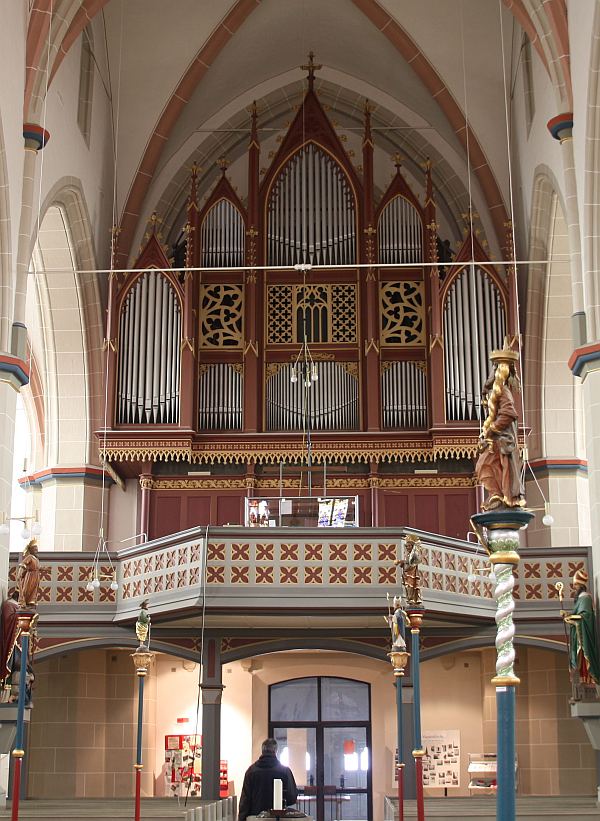 The organ in the Catholic Church of Dingelstädt, Germany, was built by Anton Feith (1902-1979) in 1932/33. It was recently restored by Karl Brode, Orgelbaumeister from Heiligenstadt, who brought back the original disposition of the instrument. The instrument has 3 manuals, pedal and 45 speaking stops, numerous playing aids and couplers. Its tonal characteristics is predominantly of a German Romantic style, but influenced by many other concepts. Feith had his own thinking about organ sound, he was very creative in this point. In Dingelstädt, we hear many inspirations. There are romantic components. Thereto some parts of a neobaroque concept, the mutations, the Glöckchen 1', the Terzian. The influences of a theater organ style: the whole organ in a swell box, the unusual character of the divisions like Main, Accompaignment, Solo, the Tibia clausa-like flutes, etc. And the original tremulant for the entire organ.
The organ in the Catholic Church of Dingelstädt, Germany, was built by Anton Feith (1902-1979) in 1932/33. It was recently restored by Karl Brode, Orgelbaumeister from Heiligenstadt, who brought back the original disposition of the instrument. The instrument has 3 manuals, pedal and 45 speaking stops, numerous playing aids and couplers. Its tonal characteristics is predominantly of a German Romantic style, but influenced by many other concepts. Feith had his own thinking about organ sound, he was very creative in this point. In Dingelstädt, we hear many inspirations. There are romantic components. Thereto some parts of a neobaroque concept, the mutations, the Glöckchen 1', the Terzian. The influences of a theater organ style: the whole organ in a swell box, the unusual character of the divisions like Main, Accompaignment, Solo, the Tibia clausa-like flutes, etc. And the original tremulant for the entire organ.
The layout of the divisons is the following: the lowest part of the organ case is occupied by the pedal stops, the accompaignment division operated from the lowest keyboard sits above it. The upper floor of the organ case is reserved for the divisions of the 2nd and 3rd keyboards, both are enclosed in a single swell box.
Originally, however, the whole organ was enclosed in a large swell box, with a mute facade in front of it. We have chosen to model this behavior for our Hauptwerk model. The swell pedal works on the entire instrument, including the pedal stops, exactly as Anton Feith designed it. Alternatively, a dedicated switch changes the swell pedal to act on 2nd and 3rd manual only, what mimics the operation of the instrument nowadays.
We also added an artificial tremulant for the IInd manual, to get the model closer to the original Feith design.
Each division has its own characteristics: 1st manual is a mezzoforte division to accompany the congregation. 2nd manual is a color division. 3rd manual is the most intense division, offering solo stops as well as the most powerful stops of the organ. Its Tuba stands on a higher pressure than the Trompete on the 1st manual, its Mixtur forms the crown of the plenum of the entire organ.
Encryption
The samples are offered in 48kHz/24bit resolution. The multiple releases have three levels: short, mid and long. Hauptwerk v.5 and higher supported. The sample set is encrypted and dongle protected, which means that it can be used with the Hauptwerk Hauptwerk software exclusively. Hauptwerk Advanced version is strongly recommended, the Lite version is not suitable to run the Surround variant of the sample set (memory limitations, audio channels limitations). There is no use of the sample set possible in any other software. The reverb time is ca. 4 seconds.
Keyboards, pedalboard
The original compass of the keyboards is 56 keys. Most stops of the 3rd manual have inner extension up to 68 pipes for the use with the super-couplers. The original compass of the pedal division is 30 sounding tones.
Tremulants
All ranks of the 3rd manual were recorded with and without tremulants for the most convincing tremulant behavior. However, loading tremmed ranks consumes large amount of RAM. It is possible to select to use the artificial tremulant instead to save RAM (the switch is located on the mixer tab). Please note, the Tuba and the Geigenprinzipal do not react to the tremulant, standing on a separate high pressure windchest.
Requirements
RAM consumption: 6-channel surround
- 16-bit, other settings default: 19.5 GB
- 20-bit, other settings default: 33.1 GB (recommended), alternative measurement 32.4 GB on a different machine.
- 24-bit, other settings default: 36.1 GB
RAM consumption: 2-channel wet
- 16-bit, other settings default: 6.6 GB
- 20-bit, other settings default: 13.3 GB
HDD space consumption: ca. 41 GB.
Screen resolution 1280x1024 px or more. Polyphony of 6000 voices recommended for the full suround (3500 pipes minimum). Polyphony of 2000 simultaneous pipes recommended for use of the wet sample set.
Surround format
The sample set is offered in the Surround variant (6 channels). In addition to the usual 4-channel surround, there are two more alternative front channels. In total, there are 4 front audio channels and 2 rear channels. The two pairs of the front ranks feature two different recording positions: direct (near to the pipes) and diffuse (distant from the instrument). These two pairs of the front ranks can either be mixed together freely to achieve any listening position between the two extremes, or used separately - depending on the prefererences of the user. A dedicated "mixing desk" is available in Hauptwerk to mix the sound to the desired level.
Attention: dragging the slider towards the extreme of the direct position may result in audio clipping if heavy music is played. If that occurs, please adjust the audio output volume on the Audio, Midi and Performance tab of Hauptwerk.
|
|
|
|
|||||||||||||||||||||||||||||||||||||||||||||||||||||||||||||||||||||||||||||||||||||||||||||||||||||||||||
Couplers:
- Normal: II/I, III/I, III/II, I-P, II-P, III-P.
- Superoct.: I/I 4′, II/I 4′, III/I 4′, III/II 4′, I/P 4′, III/P 4′
- Suboct.: I/I 16′, II/I 16′, III/I 16′, III/II 16′
- many other couplers possible via Hauptwerk Master Couplers.
Fixed combinations: P, MF, F, FF, Tutti, Ausloser, Streicherchor, Zungenchor,
Accessories: Crescendo, Crescendo ab (= Walze ab), Zungen ab, Handregister ab
Updates
No updates.
-
Dingelstaedt Surround Organ Model
Dingelstaedt Surround Sample set. Full. 6-channel surround (front-direct, front-diffuse, rear). Encrypted, dongle protected. Minimum Hauptwerk version: 5. (Also works in all higher versions.)



















